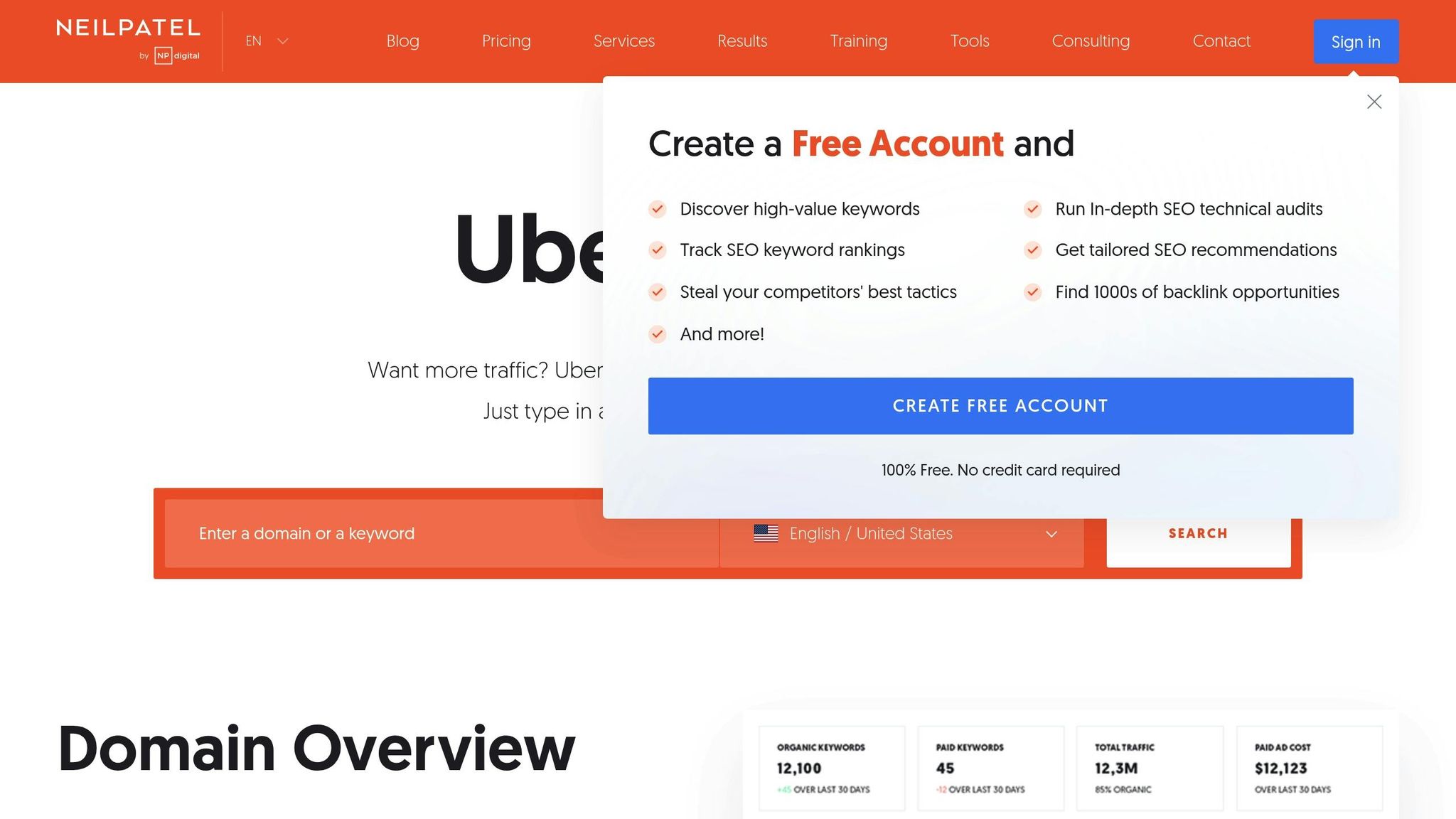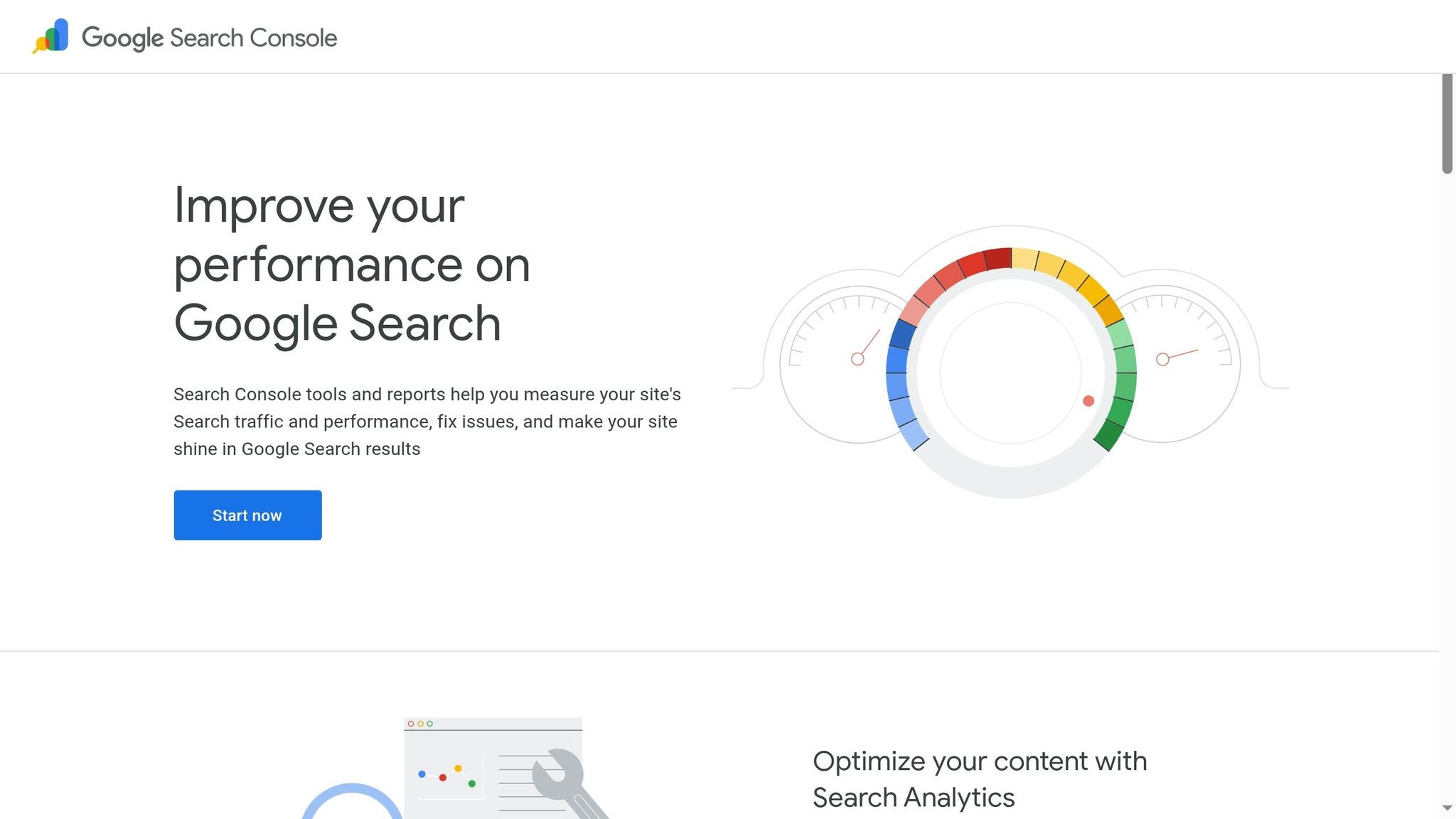Want to improve your content without spending a dime? Free content analysis tools can help you measure performance, refine strategies, and achieve better results. These tools are perfect for tracking trends, optimizing SEO, and understanding your audience - all without a steep learning curve or budget strain.
Key Takeaways:
- Why Use Them? Free tools let businesses analyze content performance, identify trends, and optimize strategies without upfront costs.
- Top Tools:
- Google Search Console: Monitors website performance and search rankings.
- Ubersuggest: Offers keyword research and competitor insights.
- Answer The Public: Reveals audience questions and search intent.
- How to Use Them Together: Combine tools for a more complete view of content performance - use one for keyword ideas, another for tracking rankings, and a third for audience insights.
Quick Comparison:
| Tool | Focus | Limitations |
|---|---|---|
| Google Search Console | Search performance | Limited to website data |
| Ubersuggest | SEO & competitor data | Free plan limits searches |
| Answer The Public | Audience questions | Caps daily searches |
With consistent use and smart combinations, these tools can help you boost rankings, engagement, and conversions - no budget required.
SEO Competitive Analysis tool and How I Use It [12 BEST TECHNIQUES]
What to Look for in Free Content Analysis Tools
Picking the right free content analysis tool can be a game-changer for your content strategy. To get the most out of these tools, start by identifying your specific goals - whether that’s boosting search engine rankings, improving content quality, or increasing engagement on social media. Your objectives will guide you toward the features that matter most for your needs. Below, we’ll break down the must-have features, platform integrations, and common limitations of free tools.
Main Features
The best free tools offer a mix of functionalities like SEO optimization, content quality checks, and performance tracking. For instance, readability scoring is a valuable feature that assesses how easy your content is to understand by analyzing sentence structure, word choice, and overall flow. Tools like the Hemingway App, which boasts a 4.4/5 rating on both G2 and Capterra, are particularly useful for simplifying your writing and making it more accessible.
SEO performance analysis is another critical feature. It evaluates factors like internal linking, meta descriptions, and content structure to help you optimize for search engines. Tools like Grammarly, which scores an impressive 4.7/5 on G2 (9,788 reviews) and Capterra (7,132 reviews), excel in refining your writing by catching grammar mistakes, suggesting stylistic improvements, and ensuring consistency. If your focus is on social media, look for tools designed to craft engaging posts and track interaction metrics across platforms.
Platform Integration
Integration capabilities are just as important as core features. Tools that connect seamlessly with platforms like Google Analytics can provide insights into traffic, bounce rates, and conversion data, helping you understand which content resonates most with your audience. For WordPress users, plugins that enable direct content optimization can be a huge time-saver.
Additionally, tools that sync with Google Search Console and social media platforms allow you to track search performance and engagement metrics. If you want to combine data from multiple sources into one professional report, linking your tools with Google Data Studio is a smart move. Before committing to a tool, test its integration features to ensure accurate and reliable data transfer between platforms.
Free Tool Limitations
Free content analysis tools can be incredibly helpful, but they do come with limitations. One common restriction is the cap on data volume - such as limits on the number of keywords tracked, pages analyzed, or reports generated. For example, some tools might only let you analyze 10 keywords or 100 pages per month, which can be a hurdle for larger websites or campaigns.
Another drawback is limited access to historical data. Many free tools only provide data from the last 30 to 90 days, making it harder to spot long-term trends or seasonal shifts in performance. Real-time analytics might also be delayed; while paid tools often update hourly, free versions may only refresh daily or weekly. Advanced features like in-depth audience insights or custom reporting are typically locked behind paywalls, which can limit the depth of your analysis.
To navigate these challenges, try combining multiple free tools to cover different aspects of your content strategy. Focus on tracking the metrics that align closely with your business goals, rather than spreading your attention too thin. Exporting data regularly can help you create your own historical archive, preserving insights even when tools reset their limits. And for critical projects, consider temporarily upgrading to a paid plan to access extra features before returning to the free version for routine tasks.
Best Free Content Analysis Tools
Here’s a look at three excellent free tools that can take your content strategy to the next level.
Ubersuggest

Ubersuggest is a popular choice for marketers who need reliable keyword research without spending a dime. The free version provides key data like monthly search volume, SEO difficulty, and paid ad metrics. It also includes a handy competitor analysis feature, showing which keywords drive traffic to competing sites and offering content ideas based on top-ranking results. Keep in mind, though, the free plan limits you to three searches per day - perfect for small businesses or solo marketers focusing on targeted research.
Google Search Console

Google Search Console is the ultimate tool for tracking website performance, and the best part? It’s completely free with no restrictions. It provides detailed insights into which search queries bring visitors to your site, along with your average keyword rankings. Plus, it alerts you to indexing problems, crawl errors, and security issues, helping ensure your content stays visible on Google.
Answer The Public

Answer The Public is a unique tool that dives into the actual questions people are asking online. Instead of just showing keyword volumes, it uncovers the real concerns and interests of your audience, making it easier to generate content ideas. It organizes queries by question types like "how", "what", "why", and "where", giving you a clear picture of user intent and potential content opportunities. While the free version limits you to one to three searches per day, each search can generate dozens of ideas to keep your content calendar packed.
Together, these tools create a powerful system: use Answer The Public to uncover audience trends, Ubersuggest for keyword and competitor insights, and Google Search Console to monitor your content’s performance.
Free Content Analysis Tools Comparison
This breakdown highlights the key differences in features, data access, and integration among popular free content analysis tools. Picking the right tool means understanding what each platform offers and how it fits your specific needs. While all three tools provide useful insights, each is tailored for a distinct purpose.
Tool Comparison Table
| Feature | Ubersuggest | Answer The Public | Google Search Console |
|---|---|---|---|
| Primary Focus | SEO metrics and competitor analysis | User questions and search intent | Search performance monitoring |
| Keyword Research | Generates keyword ideas with SEO metrics | Pulls autocomplete data from search engines | Shows queries driving traffic to your site |
| Content Ideas | Scans top-performing pages tied to keywords | Collects phrased questions, comparisons, and modifiers | N/A |
| Site Audit | Scans websites for technical SEO issues | N/A | Identifies crawl errors and other technical issues |
| Rank Tracking | Tracks changes in keyword positions | N/A | Monitors search visibility and ranking fluctuations |
| Backlink Analysis | Explores linking domains and evaluates link strength | N/A | Shows backlinks pointing to your site |
| User Interface | Clean layout with simple navigation | Single search bar with visual data output | Web-based dashboard with detailed reports |
| Integration | Limited third-party connections | Operates as a standalone tool | Integrates directly with Google Analytics |
| Best For | Small businesses seeking competitor insights | Content creators understanding audience queries | Website owners monitoring search performance |
The table above serves as a quick guide to match each tool’s strengths to your content analysis goals.
When it comes to free plans, Google Search Console stands out by offering continuous, unrestricted insights, making it ideal for long-term performance tracking. On the other hand, Ubersuggest and Answer The Public place limits on free searches, so using them effectively requires some planning.
Google Search Console integrates seamlessly with Google Analytics, providing a comprehensive view of your website’s performance. Meanwhile, Ubersuggest and Answer The Public work independently, meaning you’ll need to manually combine insights from these tools. Ubersuggest shines in technical audits and backlink analysis, while Answer The Public is excellent for uncovering user intent and trending questions.
For small businesses, a combination of tools works best: use Answer The Public to identify audience queries, Ubersuggest for competitor analysis and technical SEO, and Google Search Console for ongoing performance monitoring. Align your tool choice with your strategy to extract the most actionable insights from your content data.
sbb-itb-5174ba0
How to Use Free Content Analysis Tools
To make the most of free content analysis tools, you need more than just a basic understanding of each platform. The secret lies in combining these tools effectively and setting up a consistent review process. This ensures your content strategy stays aligned with your business goals and delivers measurable results.
Using Multiple Tools Together
Free tools each offer a unique perspective on your content's performance. By using them together, you can uncover insights that a single tool might miss. Think of it as piecing together a puzzle - each tool adds a vital piece to the bigger picture.
Start with a workflow. For example, use Answer The Public to discover trending questions your audience is asking. Then, cross-check those topics with data from Google Search Console to identify content gaps - areas where your audience's questions remain unanswered.
Google Search Console is your go-to tool for understanding organic search performance. It shows search traffic trends, user queries, and rankings. If you notice pages with high impressions but low click-through rates, tools like Ubersuggest can help analyze how competitors are using similar keywords. This can guide you in optimizing meta descriptions, titles, and content to boost clicks.
When it comes to content creation and optimization, combining tools is key. While Google Search Console provides performance data, it doesn’t address readability. That’s where tools like Hemingway or Grammarly come in. After optimizing your content for keywords, these tools help ensure it’s easy to read and engaging for your audience.
To prioritize keyword opportunities, compare data from Answer The Public with metrics from Google Search Console. This helps you decide which topics to tackle immediately and which can wait. A mixed-method approach, blending quantitative data with qualitative insights, gives you a deeper understanding of not just what’s happening with your content, but why.
Once your workflow is in place, schedule regular check-ins to keep your strategy on track.
Regular Content Reviews
A multi-tool strategy is only effective if paired with regular reviews. These reviews turn scattered insights into actionable steps, ensuring your content evolves with your audience's needs.
Set up weekly reviews using Google Search Console to monitor your top-performing pages and flag any sudden drops in traffic. Monthly reviews can focus on broader trends across multiple channels, helping you refine your strategy.
During these reviews, make sure your KPIs align with your business goals. Whether you’re aiming to increase leads, drive engagement, or improve conversions, focus on metrics that directly support those objectives. Avoid vanity metrics that don’t contribute to real outcomes.
Use historical data to establish benchmarks. Document your starting metrics when you begin using these tools, then compare future performance against these baselines. This perspective helps you distinguish between meaningful improvements and normal fluctuations.
Include content gap analysis in your review process. Map your existing content to the buyer’s journey - awareness, consideration, and decision stages. Identify missing content for each phase and prioritize filling those gaps to guide your audience through the journey.
Pay close attention to search intent alignment by analyzing search engine results pages (SERPs) for your target keywords. If your content isn’t matching what searchers are looking for, update it to include missing keywords, examples, or additional details.
Finally, document your findings and share them with your team. Summarize key insights and turn them into clear, actionable steps. This ensures everyone is on the same page and that your analysis directly informs your content creation and optimization efforts.
Regular reviews also offer an opportunity to improve internal linking. As you create new content, connect it with high-performing pages to enhance navigation for users and improve crawlability for search engines. This simple step can boost both user experience and SEO performance.
About the Marketing Analytics Tools Directory
If you're a marketer searching for reliable content analysis tools, the Marketing Analytics Tools Directory at topanalyticstools.com is your go-to resource. Sorting through countless tools can feel overwhelming, but this directory simplifies the process by organizing marketing analytics solutions into searchable categories. It’s designed to connect you directly with tools that match your specific needs.
Whether you're interested in real-time analytics, campaign performance tracking, audience insights, A/B testing, or business intelligence, the directory offers a structured way to explore both free and enterprise-level tools. It’s all about helping you find the right fit for your business goals without the hassle.
Directory Overview
This directory acts as a central hub for discovering marketing analytics tools. Unlike broader software directories, it focuses exclusively on marketing analytics, ensuring every tool listed serves a specific purpose in this field.
What sets this platform apart is its categorized layout. By grouping tools based on functionality and use cases, it saves you time and helps you uncover solutions you might otherwise miss. Each listing includes details like core features, pricing, and integrations, giving you the information you need to decide if a tool aligns with your technical needs and budget before diving deeper.
The directory caters to businesses of all sizes. Small businesses can find straightforward tools that deliver essential insights without unnecessary complexity. Meanwhile, larger enterprises can explore advanced options with robust data processing and customization capabilities.
Business Benefits
Beyond its organized listings, the directory offers tangible business advantages. The biggest perk? Time savings. Instead of sifting through endless options, you’ll find everything in one place, making comparisons faster and more efficient.
For tool providers, the submission feature is a game-changer. Businesses can submit their analytics tools to gain visibility within the marketing community. This keeps the directory updated with the latest tools and ensures users have access to emerging solutions.
The importance of analytics is clear: 77% of marketers believe that data and measurement are becoming increasingly critical. The directory supports this shift by making it easier to identify and implement the tools that fit your strategy.
And the results speak for themselves. 54% of companies using marketing analytics report higher profits than average. Even companies with over $10 billion in revenue attribute part of their growth to effective use of marketing analytics. With this directory, you can make informed decisions and choose tools that directly contribute to your business success - focusing on what works for your content strategy rather than relying on hype or popularity.
Conclusion
Free content analysis tools have become a must-have for modern marketers. With the sheer volume of data being generated daily, knowing how to analyze and refine your content is critical for staying competitive. These tools lay the groundwork for building a smarter strategy without breaking the bank.
Platforms like Google Search Console, Ubersuggest, and Answer The Public empower marketers to make data-driven decisions, even with some limitations. When used together and reviewed consistently, they can significantly enhance engagement, rankings, and conversions. In fact, research highlights that 77% of marketers expect the role of measurement, data, and analytics to grow in importance.
Key Takeaways
This guide underscores the importance of picking the right tools and using them effectively. Start by defining your goals - whether it's improving SEO, boosting content quality, or enhancing performance. From there, choose tools that align with those objectives. Combining multiple tools can give you a well-rounded perspective, as each one brings unique insights to the table.
Consistency is the cornerstone of success. Studies reveal that over 85% of web pages overlook basic SEO elements like meta robots or alt tags. Addressing these common gaps can elevate your strategy and improve your content's overall impact.
While free tools may lack some of the advanced features of premium options, they still provide actionable insights that can transform your content strategy. If you're ready to explore more options, the Marketing Analytics Tools Directory is a great resource for finding solutions tailored to your needs - whether you're running a small business or managing enterprise-level campaigns.
Ultimately, success with free content analysis tools depends on consistent use and smart decision-making. By routinely measuring your content’s performance and adapting based on the data, you’ll be in a strong position to drive better engagement, climb higher in search rankings, and boost conversions.
FAQs
What’s the best way to use multiple free content analysis tools to improve my content strategy?
To make the most of free content analysis tools, start by clearly defining your objectives. Are you aiming to boost SEO, better understand your audience’s behavior, or measure how well your content is performing? Once you know your goals, tools like keyword analyzers and content auditing platforms can help you spot areas for improvement. Pair these with analytics tools to monitor performance in real time and gain valuable audience insights.
Using a mix of tools that focus on specific tasks - like keyword research, SEO optimization, and data analysis - can help you build a well-rounded, data-driven content strategy. This method allows you to enhance engagement, fine-tune your messaging, and achieve a stronger return on investment, all while keeping in line with U.S. standards and preferences.
What challenges do free content analysis tools often have, and how can I overcome them?
Free content analysis tools often come with their own set of challenges. These can include limited features that cap the depth of your analysis, manual processes that eat up time, and the potential for bias or subjectivity in coding and interpretation.
Here’s how you can work around these hurdles:
- Automate repetitive tasks to save time and streamline your workflow.
- Establish clear coding categories to reduce bias and maintain consistency throughout your analysis.
- Pair free tools with manual reviews or extra resources to address any gaps and improve overall accuracy.
By applying these strategies, you can make the most of free tools while ensuring your analysis is both reliable and thorough.
How can I find the best free content analysis tool to match my content goals?
To find the right free content analysis tool, start by defining your main goals. If your priority is SEO and keyword optimization, tools like Google Search Console can help you monitor performance and enhance your rankings. For those aiming to understand audience engagement and content performance, platforms such as Google Analytics or BuzzSumo are excellent for spotting trends and discovering what captures your audience's interest.
Matching your choice of tools to your specific goals - whether that's refining SEO, increasing engagement, or measuring ROI - ensures you're using the best option to achieve your objectives.


